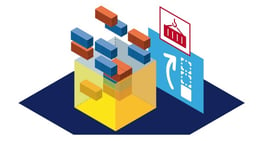How Integrated Planning Drives Revenue Growth
Nick Ostdick - October 05, 2017

 Take a television set from the 1980’s and one from 2017. Sure, both devices will function appropriately and allow you to view your favorite television show or movie, but the set from the 1980’s will clearly have a very limited set of capabilities compared with the one from 2017. The 1980’s set may not even have a remote. The picture will likely be much less clear, more grainy, and ultimately compromised. It may take a few minutes of running before the set functions properly. And odds are the set will be much more prone to malfunctions or breakdowns. On the other hand, the television from 2017 will have a much cleaner, crisper picture, allow for synergy with other applications such as a streaming device, and likely have a much longer lifespan.
Take a television set from the 1980’s and one from 2017. Sure, both devices will function appropriately and allow you to view your favorite television show or movie, but the set from the 1980’s will clearly have a very limited set of capabilities compared with the one from 2017. The 1980’s set may not even have a remote. The picture will likely be much less clear, more grainy, and ultimately compromised. It may take a few minutes of running before the set functions properly. And odds are the set will be much more prone to malfunctions or breakdowns. On the other hand, the television from 2017 will have a much cleaner, crisper picture, allow for synergy with other applications such as a streaming device, and likely have a much longer lifespan.
In short, the 2017 television set will operate at a much higher level with a more streamlined operational platform for a much longer amount of time. The probability for error will be quite low and the 2017 will work in conjunction with other modern technology.
What’s the point here? The point is this analogy is essentially the difference between a non-integrated planning platform and an integrated planning strategy in today’s manufacturing landscape. The 2017 television represents an integrated planning network where efficiency, accuracy, agility, and transparency are key elements in an integrated structure. Moving away from error-prone planning platforms like Excel spreadsheets and other manual data input and management methods makes for more effective planning and production programs, which in turn makes it easier to allocate resources for more accurate transport solutions. Optimized solutions and integrated planning software offer companies the ability to reduce the likelihood of supply chain bottlenecks and increase inventory flexibility through trend analysis, past demand reporting, forecasting, and simulation capabilities.
This makes an integrated planning architecture a core method for manufacturing companies to not only reduce costs, but also create inroads for revenue generation and growth across the value stream. With this in mind, let’s examine a handful of ways integrated planning drives revenue growth and what this growth means for today’s manufacturing companies.
Trend analysis and pattern identification
Analytics and reviews of efficiency are key for companies in leveraging the benefits of integrated planning. Isolating spikes and dips in warehouse holdings, transportation volumes, and container inventory are key to implementing a planning strategy for the upcoming year, and intelligent planning software allows planners to conduct in-depth reviews and generate simple, integrated reporting to increase supply chain transparency and reduce overall costs. In addition, trend analysis capabilities provide suppliers the ability to coordinate their planning efforts with different segments of the company – transportation, warehouse, and container management – and help create more seamless and consistent workflows.
But trend analysis capabilities can extend beyond the confines of traditional supply chain logistics to include a number of external factors that impact the supply stream. These analytics can offer manufacturers and suppliers great insight into industry-wide buying trends, which will help streamline all points of the supply stream. A report last year from Reuters indicated the current global decline in gasoline and oil prices sparked a significant increase in automotive sales last December throughout much of North America, and many economists believe this strong uptick in sales will continue throughout much of 2016. The ability to monitor this trend and produce predictive models on future fluctuations in the demand for trucks and other industrial vehicles can be crucial to manufacturers and suppliers ensuring enough product to successfully and promptly fill orders and ensure on-time delivery.
Reviews of previous demand
In today’s marketplace. Because modern manufacturing takes place on a global stage with a vast array of network partners and major players, companies have to cut through more complexity to achieve enhanced visibility and agility. As such, the margin for error relative to late deliveries and errors in product quantity is becoming slimmer and slimmer. Repeat instances of either can result in severe losses in productivity, revenue, and growth. The ability to reference past demand for products is essential in ensuring these products ship and are delivered on-time and in the correct quantities. Integrated planning software also helps increase the visibility and transparency for past demand across an entire company, allowing for a more collaborative, coordinated effort in creating consistent, synchronized planning. The more individuals with access to a company’s past demand data, the more capable that company will be in creating accurate and efficient forecasting. A better understanding of what you’ve been gives planners and managers a more accurate picture of where you’re going, which allows companies to unlock business moments and opportunities to leverage production sequences more in-line with customer or market demand.
Enhanced simulations and forecasting
In such a complex industry, it would stand to reason the ability to forecast future planning and production programs based on analytics, prior customer demand, and potential market forces would be a critical function for planners and managers in an integrated planning platform and to help reduce transport costs. Forecasting capabilities via intelligent planning software can also be useful in establishing sales and supply chain benchmarks to help promote and encourage a company’s organic growth. Establishing such benchmarks and creating an accurate prediction of supply and sales over an upcoming span of time better equips a company to determine how and where to best allocate sales, shipping, container and warehouse resources to eliminate waste and increase communication across a variety of positions. In addition, the ability to run simultaneous simulations for a variety of potential supply chain bottlenecks is a value-added proposition for any manufacturing company looking for methods of increasing visibility and transparency across a variety of platforms, while at the same time reducing costs and increasing communication and collaboration in a cross-organizational manner.
LATEST POSTS
- Understand Circular Economy in The Manufacturing Industry
- How Can Industry 4.0 IT Integration Be Achieved Smoothly?
- The Significance of Order Sequencing in Discrete Manufacturing
- How to improve your Supply Chain Management: The Power of Control Towers
- Optimizing Human Resource Scheduling in Manufacturing: A Technological Approach



